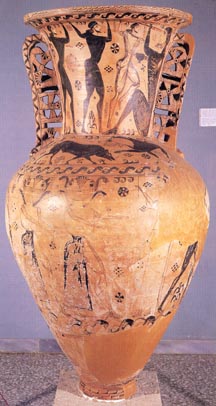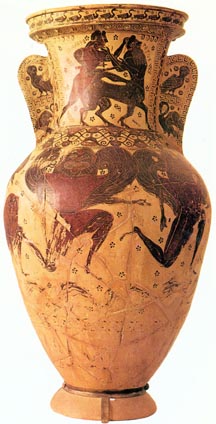
Protoattic Amphora
the "Analatos" amphora
c. 700-675 BCE
Height: 2 feet 71/2 inches
(Musée du Louvre, Paris)
The Analatos Painter was one of the main proponents of the shift from the Geometric aesthetic to that of the Orientalizing Period. Within a rigorous
framework, his use of line drawing brings the human figures to life. This long-necked amphora (also called a loutrophoros) is decorated in superposed registers in which appear sphinxes, dancers, and chariots drawn in silhouette or in line, with various curvilinear and vegetal motifs between.

Protoattic Amphora
the "Eleusis" amphora
c. 650 BCE
Height: 4 feet 9 inches
(Archaeological Museum, Eleusis)
This large Dipylon-like vase has figure decoration on one side (the reverse side is decorated with a design of intertwined plants). On the body, in a panel over 20" inches high, is told the story of Perseus. Medusa is shown headless under one of the handles while her sister Gorgons advance to the right, to be stopped by Athena as Perseus flees with Medusa's head (the last two figures are badly preserved). The Gorgons, their outlines partially filled with white, are not the standard Gorgon type known from elsewhere. On the shoulder, is a scene of animal combat, with the head of a lion in outline and its body in black figure, attacking a boar. On the neck, in a panel about 15" high, is depicted the Blinding of Polyphemos. Odysseus alone is painted in the same technique as the Gorgons below (singles him out as the hero). The other figures, Odysseus's companions, are described in a combination of silhouette and outline, with a few details (toes, fingers, beard) incised. Together the human figures are shown driving the stake into the single eye of the cyclops, Polyphemos. Odysseus's right leg is fully extended, his left knee is braced against Polyphemos's knee, and he throws all his weight behind the thrust. Polyphemus appears to howl in agony as he vainly attempts to pull out the stake with one hand, his other hand still holding the wine cup. The painting catches all the violence and dynamic of the Homer's account.

Late Protoattic / Early black-figure Amphora
the "Nessos" amphora
c. 625-600 BCE
Height: 4 feet
(National Archaeological Museum, Athens)
First masterpiece of this new Attic Black Figure style. A monumental grave marker with figured scenes on one side only. On the neck is Herakles and the Centaur Nessos (with names written in the field - in Attic dialect Nessos pronounced Nettos, and in local script one "t" stood for two - hence "Netos"). Herakles is shown jamming his foot into the small of the centaur's back as he grabs a fistful of the centaur's hair and prepares to deliver the fatal sword thrust. Nessos' knees buckle, his mouth open in horror. The design is controlled yet dynamic, with the figures overlapping the frame. There are powerful contrasts between Herakles stern, unmoved face, and the desparate, shaggy centaur's open, imploring gestures (chin touching a conventional gesture of entreaty in Archaic art). On the body is the story of Perseus, but with only the Gorgons, running energetically in the stylized "knee-run" pose to the right. They show a more conventional type of Gorgon face (masklike, with tusks, protruding tongue) that will recur again and again in Archaic art. The artist has acquired a new set of visual formulae and a sense of order.
|

 SPRING 2016
SPRING 2016  SCHEDULE
SCHEDULE  REQUIREMENTS
REQUIREMENTS

 SPRING 2016
SPRING 2016  SCHEDULE
SCHEDULE  REQUIREMENTS
REQUIREMENTS